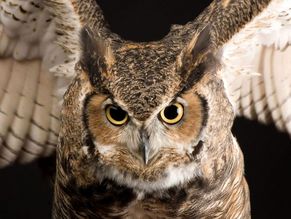Great Horned Owl (Bubo virginianus)

Description: Great Horned Owls don’t necessarily have the same coloration, but often they can be any where from reddish brown to grey, black, and white. Two of their defining features are the fact that they have large yellow eyes, and the tuft of feathers found on their heads, which appear to be horns, and while they are found over the ears they have nothing to do with hearing. Great Horned Owls however, are extremely unique from other birds in another way; their feet are feathered all the way to the end of their talons. Females are larger than the males sometimes almost 30% larger. The average female is found to be between 45 cm and 54cm with a wingspan up to 152cm.
Habitat: Great Horned Owls are usually found in wooded areas, and are found spread wide across North, Central, and South America, extending their territory all the way north to subarctic North America. They have been found to nest in deciduous, coniferous, tropical rain forests, and in mangrove trees. They can live in arctic areas, as well as prairies, deserts, and swamps. Once these owls are mated they will make their nest their current residence and will never leave their established territory with the exception of hunting.
Diet: Great Horned Owls will hunt by perching on branches or poles, then gliding above the ground to snare prey. When higher up they will dive down with their wings folded and snare prey in its talons, killing most prey instantly. These owls can swallow rodents and small rabbis whole. They prey on small mammals including squirrels, minks, skunks, raccoons, armadillos, porcupines, shrews, moles, muskrats, and bats. Great Horned Owls are also known to eat a wide variety of birds including all Owls (other than the Snowy Owls), grouse, woodpeckers, crows, turkeys, pigeons, Red-tailed Hawks, bitterns, Great Blue Heron, ducks, swans, gulls, and have been known to invade chicken coops, kill, and carry away several chickens. In the reptile department they eat snakes, turtles, lizards, and young alligators. Great Horned Owls have a wide variety of water life including amphibians such as frogs, salamanders, and toads. Other prey includes fish, large insects, scorpions, centipedes, crayfish, worms, and spiders. In total the Great Horned Owl is known to eat 250 different species of animals.
Behaviors:
Miscellaneous:
Habitat: Great Horned Owls are usually found in wooded areas, and are found spread wide across North, Central, and South America, extending their territory all the way north to subarctic North America. They have been found to nest in deciduous, coniferous, tropical rain forests, and in mangrove trees. They can live in arctic areas, as well as prairies, deserts, and swamps. Once these owls are mated they will make their nest their current residence and will never leave their established territory with the exception of hunting.
Diet: Great Horned Owls will hunt by perching on branches or poles, then gliding above the ground to snare prey. When higher up they will dive down with their wings folded and snare prey in its talons, killing most prey instantly. These owls can swallow rodents and small rabbis whole. They prey on small mammals including squirrels, minks, skunks, raccoons, armadillos, porcupines, shrews, moles, muskrats, and bats. Great Horned Owls are also known to eat a wide variety of birds including all Owls (other than the Snowy Owls), grouse, woodpeckers, crows, turkeys, pigeons, Red-tailed Hawks, bitterns, Great Blue Heron, ducks, swans, gulls, and have been known to invade chicken coops, kill, and carry away several chickens. In the reptile department they eat snakes, turtles, lizards, and young alligators. Great Horned Owls have a wide variety of water life including amphibians such as frogs, salamanders, and toads. Other prey includes fish, large insects, scorpions, centipedes, crayfish, worms, and spiders. In total the Great Horned Owl is known to eat 250 different species of animals.
Behaviors:
- Their eyes are fixed into their eye sockets making it impossible for their eyes to scan back and forth. To compensate for this they are able to move their heads a full 270 degrees to see all around them
- Their ears are also set up to be slightly off center so that one is higher than the other. This allows for them to better identify where sound is coming from and can pinpoint sounds above and below them
- Great Horned Owls are some of the earliest-breeding birds breeding in late January, and almost always take over old crow or Red-tailed Hawk nests
- Great Horned Owl chicks will generally be seen being taught to fly at six weeks of age
Miscellaneous:
- Great Horned Owls have a crushing force of around 300 pounds. Human hands have a crushing force of 60 pounds
- Great Horned Owls can make over 15 different sounds
- Only natural predator is Man
- Great Horned Owls are the provincial bird of Alberta
- Can be awake day or night, but generally nocturnal
- Owl feathers are comb like and “fringed” allowing for them to move virtually silently
- Great Horned Owls are the primary predator of skunks in North America

